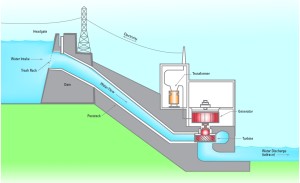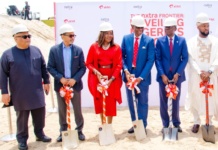West African states in the Niger River Basin are seeking to tackle climate risks and reduce poverty by constructing three hydropower dams in the next five years.
In late November, the Council of Ministers of the Niger Basin Authority (NBA), meeting in Cameroon’s capital Yaounde, endorsed an environmental and climate action plan for sustainable management of the scenic basin and its rich natural resources, which have come under threat from climate change.
The projects include a 102 megawatt (MW) hydropower dam at Fomi in Guinea, a 25 MW hydropower plant in Toussa, Mali, and the 565 MW Kandadji dam in Niger. These aim to boost hydro-electricity and irrigation, reduce desertification and flooding, and improve economic activities across the region.
“The West African region is facing urgent problems of food security, rural poverty and climate change that demand answers in the form of investment and infrastructure. We need to give a push to these three multi-purpose hydropower dam projects as a sustainable solution that involves the region’s largest river,” NBA executive secretary Collins Ihekire said in a statement at the Yaounde gathering.
The NBA is the coordinating body for the 4,200 km-long (2,600-mile) Niger River, bringing together the governments of Benin, Burkina Faso, Cameroon, Chad, Côte d’Ivoire, Guinea, Mali, Niger and Nigeria.
The NBA also agreed to rehabilitate three hydropower plants at Kainji, Jebda and Lagdo, as well as multiple run-of-river hydropower stations, optimise water storage, set up irrigation schemes for an additional 1 million hectares (2.5 million hectares) of land, and increase hydropower production to 1,000 gigawatt hours per day.
“Integrating future climate change adaptation and mitigation into our development action plan will enable…sustainable management of our water resources, to better the livelihood of the over 106 million population in the area,” said Emmanuel Nganou Djoumesi, Cameroon’s minister of the economy, planning and regional development, at the closing of the Yaounde meeting.
BOOST TO FOOD SECURITY
The decision to reinforce climate and environmental protection in the basin comes after a series of World Bank-funded studies to assess climate risk in the area.
The research concluded that “the impacts of climate change on minimum water flow in the river are potentially severe”, according to an NBA report. “Rain-fed agriculture in the area is vulnerable to climate change. Crop yields have reduced by more than 15 percent in the last five years due to increase in temperature by more than 2 degrees.”
This has undermined food production, especially in the Sahel region, which includes NBA member states like Cameroon, Chad, Niger and Nigeria, which have high rates of child malnutrition, the report said.
As well as generating electricity for surrounding areas, the new dams will also boost production of crops like rice and vegetables, and alleviate the impacts of climate change, authorities say.
“The Fomi multi-purpose dam in Guinea will not only provide hydroelectric power, but its reservoir will create opportunities for fishing. Areas around the reservoir will also be suitable for raising cattle and other types of livestock as well as for agriculture. The new body of water will also provide a habitat for aquatic birds,” the NBA report said.
The $384 million project will enable regulation of water levels in the Niger River, benefiting countries downstream by making irrigation possible during the dry season, the NBA says.
The Taoussa dam in Mali – estimated to cost $38 million – is slated to generate electricity for Burkina Faso and Niger, and could eventually provide irrigation for nearly 140,000 hectares.










